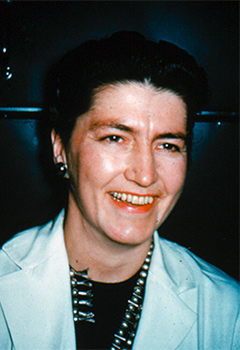Mary Stults Sherman, the first female orthopaedic surgeon to pursue an academic career in the United States and the first woman to be elected to the AOA as a member, is being honored as an AOA Pillar of the Orthopaedic Profession for her significant contributions to orthopaedics and research. Dr. Sherman’s recognition is being championed by Michael A. Simon, MD, FAOA.
Bio
The first fifteen years of Dr. Sherman’s distinguished medical career unfolded at the University of Chicago. She and her husband Thomas Sherman both matriculated as medical students at the University of Chicago Medical School in 1937, and Mary graduated as the top student in her class. She first pursued an internship in pediatrics, but ultimately accepted an offer from Howard Hatcher to join the orthopaedic residency in 1942. Her orthopaedic education in the Department of Surgery brought her into close contact with two legendary figures in orthopaedic surgery: Dallas Phemister, a master surgeon-researcher who operated on all parts of the body who founded and chaired the Department of Surgery for over two decades; and Howard Hatcher, a master educator now remembered as the father of orthopaedic oncology in the United States.
During World War II, orthopaedic residents were scarce in Chicago, and for a time Dr. Sherman was the sole resident assisting Hatcher with orthopaedic care at the University of Chicago. The 1943 polio epidemic, which led to a shortage of hospital beds in Chicago, provided the basis for an important case study by Dr. Sherman.
She was promoted to Instructor in 1944 and Assistant Professor in 1948 at the University of Chicago. During these years, Dr. Sherman made seminal contributions to orthopaedic research with her articles The Pathology of Ununited Fractures of the Neck of the Femur (1947, co-written with Phemister) and Osteoid Osteoma: Review of the Literature and Report of Thirty Cases (1947). She left the University in 1952 to assume a role at the Ochsner Foundation and Hospital in New Orleans. In 1954, at the age of forty-one, Sherman became the first woman to be elected to the prestigious American Orthopaedic Association (AOA).
In New Orleans, Sherman maintained the productive balance among research, teaching, and clinical activity that she believed to be essential in an academic medical career. She joined the faculty of Tulane University as an Associate Professor of Orthopaedic Surgery, where she participated in orthopaedic resident education, and in 1956 became a partner at Ochsner, where she directed the Bone Pathology Laboratory. Throughout her years in New Orleans Sherman maintained a high level of productivity in research, authoring articles on a variety of topics in bone and joint pathology. Her 1952 article on psoriatic arthritis has been celebrated as “the first comprehensive report in English” on the topic. She was the first woman awarded a Kappa Delta Award from the American Academy of Orthopaedic Surgeons (AAOS) in 1963 for her study of talipes equinovarus with Dr. R. N. Irani.
Dr. Sherman attained leadership positions on the national stage. She served as Chair of the Pathology Committee of the AAOS and was the first woman oral examiner for the American Board of Orthopaedic Surgery (ABOS). She was a charter member of the Orthopaedic Research Society (ORS), and a member of many national and international professional organizations, including the International Society of Orthopaedic Surgery and Traumatology, and the Sociedad Latino-Americana de Ortopedia y Traumatologia. She also served as an associate editor for the Journal of Bone and Joint Surgery (JBJS). Sherman maintained a lifelong interest in bone pathology, which was reflected in her research and pedagogy.
In 1964, Mary Sherman’s remarkable life was cut short in a brutal murder; over half a century later, the murder remains unsolved. The premature death of Mary Sherman in only her 52nd year of life, in her prime as a teacher, clinician, and researcher, remains an enormous loss to the orthopaedic community. Dr. Mary Sherman was an exemplary founder of women leaders in academic orthopaedic surgery.
The AOA gratefully acknowledges Dr. Sherman’s extensive and comprehensive impact on the orthopaedic community and recognizes her as an AOA Pillar of the Orthopaedic Profession.
Tribute
“Dr. Mary Stults Sherman, the first woman orthopaedic surgeon to pursue an academic career, has been unrecognized in the history of orthopaedic surgery in the USA. In the years during and following World War II, the Orthopaedic Surgery Division of the Department of Surgery at the University of Chicago was staffed by two faculty: C. Howard Hatcher and Mary Sherman. Sherman remained the first and only woman in the Department of Surgery until 1952. Despite her continued advancement in research, Sherman never attained tenure, and she moved to Ochsner Clinic Medical Foundation in New Orleans and subsequently became a faculty member at Tulane.
Sherman had many ‘firsts’ as an academic orthopaedic surgeon. She was the first woman to be elected to the AOA, (1954), first woman to receive the Kappa Delta Award (1963), the only woman charter member of the Orthopaedic Research Society (ORS) and the first woman to be an oral examiner for the American Board of Orthopaedic Surgery (ABOS).”
– Michael A. Simon, MD, FAOA
Dr. Sherman’s Champion
